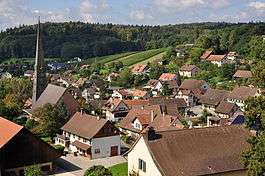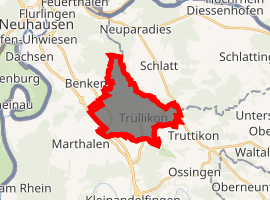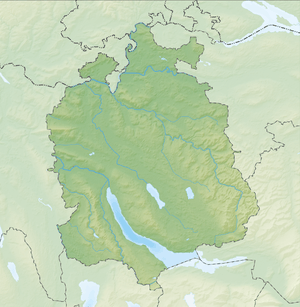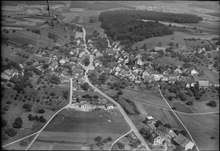Trüllikon
Trüllikon is a municipality in the district of Andelfingen in the canton of Zürich in Switzerland.
Trüllikon | |
|---|---|
 | |
 Coat of arms | |
Location of Trüllikon 
| |
 Trüllikon  Trüllikon | |
| Coordinates: 47°38′N 8°42′E | |
| Country | Switzerland |
| Canton | Zurich |
| District | Andelfingen |
| Area | |
| • Total | 9.80 km2 (3.78 sq mi) |
| Elevation | 435 m (1,427 ft) |
| Population (2018-12-31)[2] | |
| • Total | 1,066 |
| • Density | 110/km2 (280/sq mi) |
| Postal code | 8466 |
| SFOS number | 0040 |
| Surrounded by | Benken, Kleinandelfingen, Laufen-Uhwiesen, Marthalen, Ossingen, Schlatt (TG), Truttikon |
| Website | www SFSO statistics |
Geography

Trüllikon has an area of 9.5 km2 (3.7 sq mi). Of this area, 63.1% is used for agricultural purposes, 29.4% is forested, 7.3% is settled (buildings or roads), and the remainder (0.2%) is non-productive (rivers, glaciers or mountains).[3]
Demographics
Trüllikon has a population (as of 31 December 2018) of 1,066.[4] As of 2007, 5.4% of the population was made up of foreign nationals. Over the last 10 years the population has decreased at a rate of -0.3%. Most of the population (as of 2000) speaks German (94.6%), with Italian being second most common ( 0.7%) and Serbo-Croatian being third ( 0.6%).
In the 2007 election the most popular party was the SVP which received 52% of the vote. The next three most popular parties were the SPS (14.7%), the Green Party (10.8%) and the FDP (7.3%).
The age distribution of the population (as of 2000) is children and teenagers (0–19 years old) make up 23.5% of the population, while adults (20–64 years old) make up 64% and seniors (over 64 years old) make up 12.5%. In Trüllikon about 79.8% of the population (between age 25-64) have completed either non-mandatory upper secondary education or additional higher education (either university or a Fachhochschule).
Trüllikon has an unemployment rate of 1.53%. As of 2005, there were 141 people employed in the primary economic sector and about 39 businesses involved in this sector; 64 people are employed in the secondary sector and there are 14 businesses in this sector; 90 people are employed in the tertiary sector, with 26 businesses in this sector.[3]
References
- "Arealstatistik Standard - Gemeinden nach 4 Hauptbereichen". Federal Statistical Office. Retrieved 13 January 2019.
- "Ständige Wohnbevölkerung nach Staatsangehörigkeitskategorie Geschlecht und Gemeinde; Provisorische Jahresergebnisse; 2018". Federal Statistical Office. 9 April 2019. Retrieved 11 April 2019.
- Swiss Federal Statistical Office accessed 28-Jul-2009
- Swiss Federal Statistical Office - STAT-TAB, online database – Ständige und nichtständige Wohnbevölkerung nach institutionellen Gliederungen, Geburtsort und Staatsangehörigkeit (in German) accessed 23 September 2019